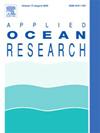Optimization of the mooring system of a floating wind turbine by developing a surrogate model-assisted evolutionary framework
IF 4.3
2区 工程技术
Q1 ENGINEERING, OCEAN
引用次数: 0
Abstract
In the design and optimization of Floating Wind Turbines (FWTs), there are challenges related to the large number of design parameters and the need for efficient and accurate calculation of turbine dynamic responses. To address these issues, this study proposes a surrogate model-assisted evolutionary framework for the mooring system optimization of shallow-water wind turbines. This distinct feature of the optimization framework lies in that it employs a sparse polynomial chaos expansion surrogate model to quickly predict the performance indicator values of FWTs with different mooring configurations and adopts the differential evolution algorithm to find the mooring parameter combination with the best performance, achieving efficient, accurate, and automated multi-parameter optimization. The framework is utilized to optimize the mooring system for a FWT at a relatively shallow water depth, through defining a mooring performance evaluation indicator as the objective function that comprehensively considers mooring line tensions, platform motions, anchor tensions, and the mooring line material cost. Based on the optimization application, the accuracy of the optimization framework is verified. The dynamic responses and safety assessments of the optimized FWT in the fatigue limit state (FLS) and ultimate limit state (ULS) are conducted. The results demonstrate the effectiveness of the proposed optimization framework in enhancing a FWT's performance according to flexibly defined objective functions.
求助全文
约1分钟内获得全文
求助全文
来源期刊

Applied Ocean Research
地学-工程:大洋
CiteScore
8.70
自引率
7.00%
发文量
316
审稿时长
59 days
期刊介绍:
The aim of Applied Ocean Research is to encourage the submission of papers that advance the state of knowledge in a range of topics relevant to ocean engineering.
 求助内容:
求助内容: 应助结果提醒方式:
应助结果提醒方式:


